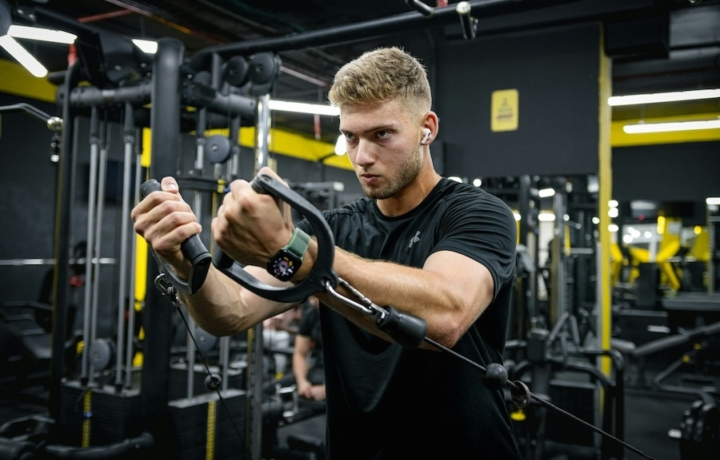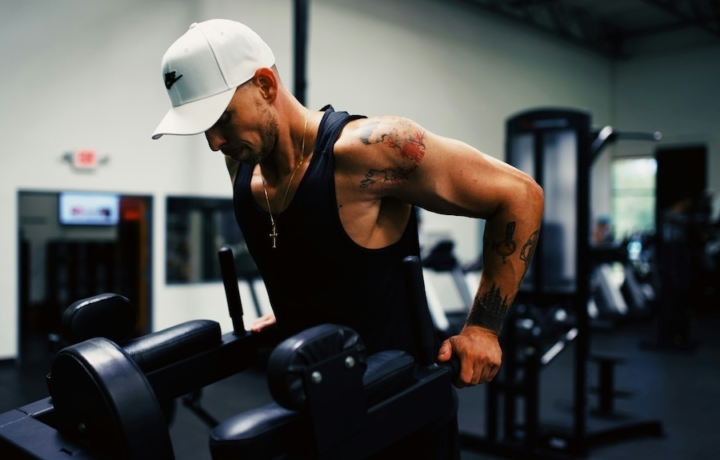Exercise
Barbell Decline Bench Press

Barbell Decline Bench Press
Calculate your one rep max
How to Perform
- Secure yourself on the decline bench with your feet hooked under the leg supports and your head positioned lower than your hips.
- Grasp the barbell with a grip slightly wider than shoulder-width, using an overhand grip with wrists straight and elbows at 90 degrees.
- Unrack the barbell by extending your arms and position it directly over your lower chest with arms fully extended.
- Inhale deeply and brace your core as you slowly lower the barbell toward your lower chest, keeping your elbows at approximately a 45-degree angle from your torso.
- Lower the bar with control until it lightly touches your lower chest, maintaining tension in your chest muscles throughout the movement.
- Push the barbell back up in a straight line by driving through your chest muscles while exhaling, keeping your back pressed firmly against the bench.
- Extend your arms fully at the top of the movement without locking your elbows, maintaining shoulder blade retraction for stability.
- Repeat for the desired number of repetitions, focusing on a controlled tempo and full range of motion with each rep.
Important information
- Keep your feet securely hooked under the leg supports throughout the entire exercise to prevent sliding down the bench.
- Maintain a natural arch in your lower back and keep your shoulder blades retracted and depressed for optimal chest engagement.
- Never bounce the bar off your chest as this reduces muscle tension and increases injury risk.
- Consider using a spotter when working with heavier weights, especially due to the awkward decline position that makes self-racking more challenging.
1 Rep Max Calculator
Estimate your one-rep max for Barbell Decline Bench Press

Barbell Decline Bench Press
Calculate your one rep max
Exercise Details
Primary Muscles
Muscle Groups
Mechanic
Risk Areas
1 Rep Max Calculator
Estimate your one-rep max for Barbell Decline Bench Press
Built for progress
Take the guesswork out of training
Create personalized AI-powered workout plans that evolve with you. Train smarter, track every rep and keep moving forward, one workout at a time.






The Barbell Decline Bench Press stands as a powerful compound movement that has earned its place in both bodybuilding and powerlifting circles. This intermediate-level exercise predominantly targets the lower portion of the pectoral muscles while engaging the triceps and front deltoids as crucial secondary movers. The unique angle of the decline bench shifts emphasis to the lower chest fibers, creating a more comprehensive pec development when programmed alongside flat and incline variations.
Unlike its flat bench counterpart, the decline position reduces shoulder strain for many lifters while allowing for potentially heavier loads due to the shortened range of motion and advantageous leverage. This makes it particularly valuable for strength enthusiasts looking to overload the pressing muscles with substantial weight. The mechanical efficiency of this movement often enables lifters to handle 5-10% more weight than they might on a traditional flat bench.
For bodybuilders, the decline bench press delivers that coveted lower pectoral development and contributes significantly to creating a full, balanced chest appearance. The exercise promotes hypertrophy through substantial time under tension and the ability to handle challenging loads. Meanwhile, powerlifters appreciate the carryover strength benefits to competition bench pressing, as the decline variation can help overcome sticking points and build pressing power.
Research suggests that EMG activity in the lower pectoral region is notably higher during decline pressing compared to flat or incline variations, confirming its effectiveness for targeting this specific area. This makes it an excellent option for those looking to bring up lagging lower chest development or simply add variety to their pressing movements.
While sometimes overlooked in favor of its flat and incline siblings, the decline bench press delivers remarkable strength and muscle-building benefits when properly programmed. Whether incorporated as a primary movement or as an accessory exercise, it offers unique advantages that can help intermediate lifters continue progressing toward their physique and performance goals.
FAQ - Barbell Decline Bench Press
The decline bench press primarily targets the lower portion of the pectoral muscles, with significant engagement of the triceps and anterior deltoids as secondary movers. EMG studies confirm higher activation in the lower chest region compared to flat or incline variations.
Yes, many lifters with shoulder issues find the decline bench press more comfortable than flat benching because it places less stress on the shoulder joint. The decline angle reduces the degree of shoulder extension required, creating a more mechanically advantageous position.
Most lifters can handle approximately 5-10% more weight on the decline bench press compared to their flat bench due to the shortened range of motion and better mechanical leverage. Start with 90% of your flat bench weight to establish proper form before potentially increasing.
The most common mistakes include inadequate leg securing (sliding up the bench), bouncing the bar off the chest, and excessive arching. Focus on controlled lowering, maintain firm contact with the bench, and ensure your feet are properly secured in the leg pads.
Include the decline bench press 1-2 times weekly as either a primary chest movement or an accessory exercise after flat bench work. Allow 48-72 hours of recovery between sessions, adjusting frequency based on your overall training volume and recovery capacity.









